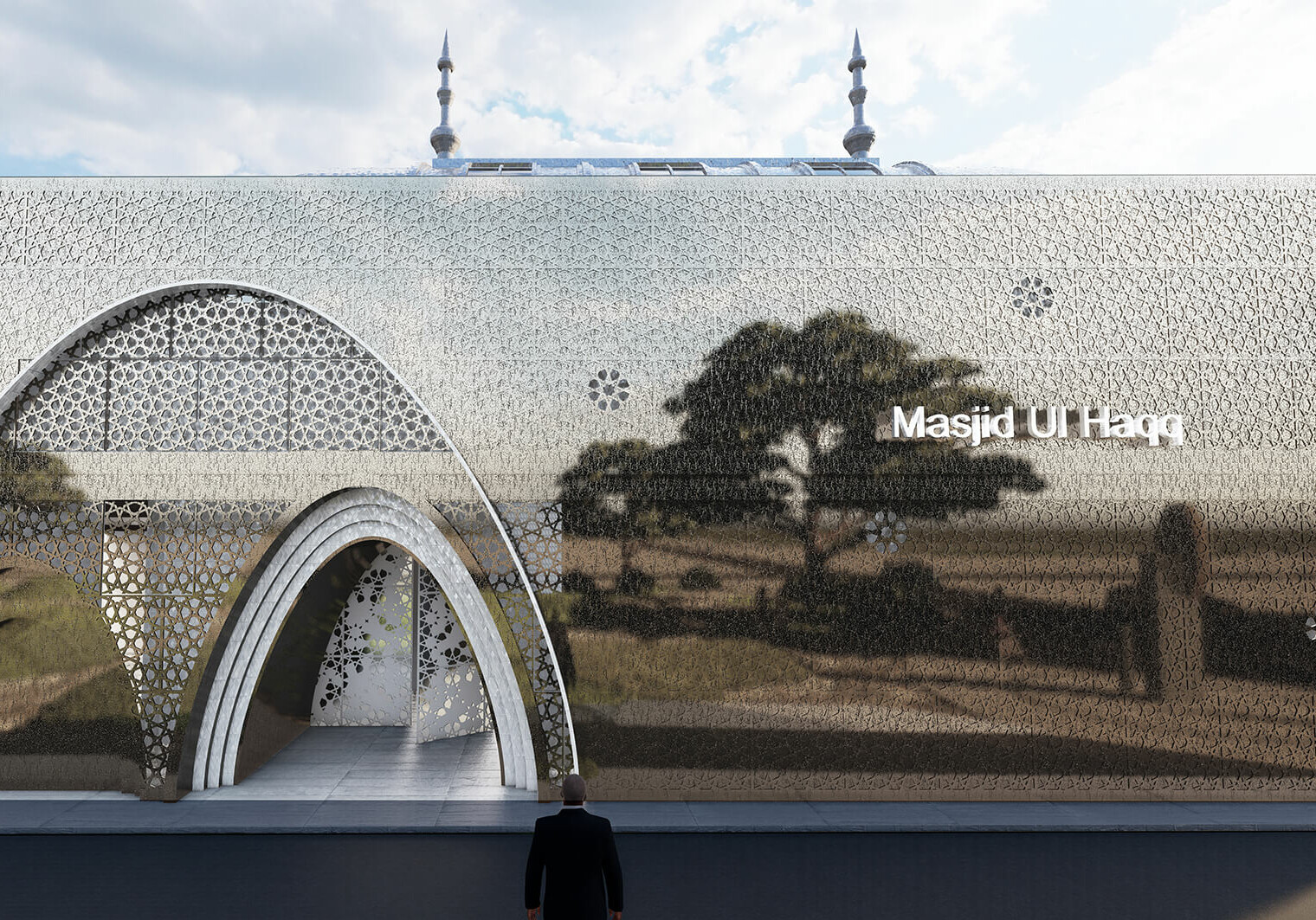Masjid Ul-Haqq is the oldest Islamic place of worship in Baltimore. Today, Laya Architects is working with mosque leadership and community members to revitalize the building with deep roots in the city’s historic Upton neighborhood, just northwest of downtown.
The effort to restore Masjid Ul-Haqq started last Ramadan and is part of a vision called Masjid Ul-Haqq 2030. The goal is to expand the building for the mosque’s fast growing congregation; add more capacity for classrooms, prayer, and community functions; and rectify the existing 19th-century building’s structure and mechanical operations.
By 2030, the building’s exterior will be completely transformed by Laya Architects, and a new prayer hall will be added to the second floor topped with four minarets. Inside, an archive, cafeteria, and refurbished restrooms will abound. The area outside the mosque will boast a public amphitheater, art walk, farmers market, heritage exhibit, skate park, paradise garden, and basketball court. There will also be an exhibition area near the main entrance that tells the building’s remarkable history.
Laya Architects was founded by Prabhu Sugumar and has offices in Chennai, India; and Beijing, China. Sugumar, a Sci-Arc grad now based in Beijing, is hoping to grow a New York office in the near future. The office has expertise in projects that emphasize and enhance cultural identity through architectural design.
In Baltimore, Sugumar proposed a new facade for Masjid Ul-Haqq (Arabic for Mosque of the Truth) that’s both contemporary and evocative of traditional Islamic architecture. Upon completion, aluminum panels with mirrored surfaces will be clad to the existing structure, transforming its experiential properties.
“The usage of mirrors in the form of reflective aluminum panels emerged as a perfect solution, considering the 154-year-old building stands as an honest reflection of the metamorphosis of the Upton neighborhood,” Sugumar told AN. “Mirrors have always been a significant feature in Islamic buildings because they signify humility, honesty, and other basic virtues. The patterns we derived are based on existing geometries we found within the building’s interior.”


The building situated at 514 Islamic Way (formerly Wilson Street) dates back to 1870. For decades, it was used as a livery station, and later as a garage. During the Great Migration, Upton became one of Maryland’s first middle class African American neighborhoods. Booker T. Washington, Marcus Garvey, and W.E.B. Dubois were known to give speeches at local institutions, and Upton’s Pennsylvania Avenue was the heart of Black commerce in Baltimore—an area which often drew comparisons to Harlem’s 125th Street. U.S. Supreme Court Justice Thurgood Marshall lived in Upton, and so did Clarence Mitchell, a civil rights activist from the NAACP.
The Nation of Islam’s Baltimore chapter led by Minister Isaiah Karriem moved into the 2-story brick building in 1958. Shortly after, it became Muhammed Mosque No. 6. Minister Karriem eventually raised $60,000 to build an auditorium attached to the rear end of the 300-seat temple. The auditorium was designed to accommodate 1,000 people and support the community. “The only way to end juvenile delinquency is to get children in off the streets,” Karriem said while raising funds for the gymnasium. “We feel that this is a step in that direction.”

By the 1960s, Muhammed Mosque No. 6 had become a vital community center that contained a library, a cafeteria, a minister’s study, a food co-op, and Shabazz Restaurant; and it garnered over 3,000 members. Overtime, Elijah Muhammed, Stokely Carmichael, Malcolm X, and Muhammed Ali spoke there about racial injustice. When Elijah Muhammed visited in 1962, it was standing room only inside the 1,000-seat auditorium, and another 500 people spilled out into the street to listen.
Between 1968 and 1994, a school was there for both Muslim and non-Muslim children that graduated many important community leaders. After Elijah Muhammed died in 1975, the mosque was renamed Masjid Muhammed. In 1994, it became Masjid Ul-Haqq. The building was designated a Baltimore historic landmark in 2003.
These past two decades, the building has suffered from wear and tear. Sugumar joined the project team at Masjid Ul-Haqq in 2023; he was working for the Islamic Society of Baltimore when members of Masjid Ul-Haqq reached out for services.
“I was reached out to by some members of the Masjid Ul-Haqq community around a year and a half ago,” Sugumar said. “Initially, the Masjid needed some interior work, but after conversations about the Masjid and its history, the project evolved into a comprehensive vision that reimagines a new cultural identity for both the neighborhood and the city. The low ceiling height of the second floor prompted us to consider opening up the roof to create a vaulted prayer area.”

“The collaboration ever since has been fantastic,” Sugumar added. “There’s so much support coming in, especially from the African American community in Upton, we’ll need more. We hope to change lives for the better.”
Moving forward, Laya Architects is working with mosque leadership and a local architect to bring the renovation project across the finish line. The group is currently raising funds for the effort and will finalize a cost analysis in the coming months.
A link for donations can be accessed at Masjid Ul-Haqq 2030.

